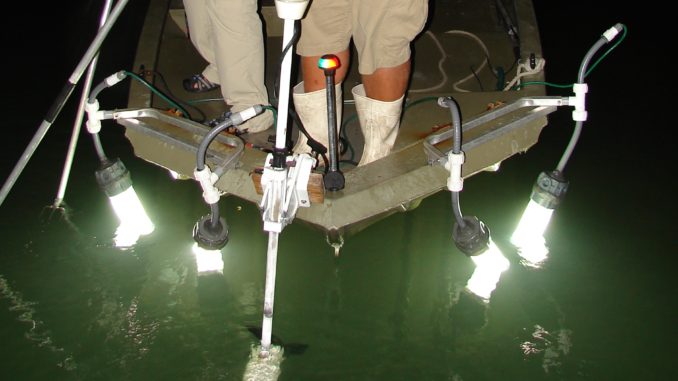
As flounder gigging is done at night, lights are required, and they’ve come a long way.
Many years back, giggers carried a lantern they held just above the water, but the light given off by the lantern was minimal, and fisherman had to stare down through the light and the glare reflecting off the water.
The next step was to enclose light bulbs in waterproof containers so they could be lowered at least partially into the water and reduce the glare. The first of these used 12-volt DC lights as they had to be powered by batteries. Fishermen could add more lights to see better, but they drained the battery more quickly.
The SRM Multi-light by Sea Striker (www.seastriker.com) was one of the first submergible lights made expressly for gigging. Lights were attached to a pole that had a C-clamp, which allowed clamping the lights to the bow of a boat and adjusting the angle and depth of the light. They are still very popular, especially in the Carolinas.
Once generators became small and quiet enough to could be used for the power, lighting options for gigging expanded rapidly. Many giggers switched to AC lights, able to increase the power to several hundred watts per bulb. With the power to run them available, giggers began making rigs with multiple lights that improved their ability to spot flounder nestled in on the bottom.
The next step was to use LED lights, which draw far less power. With power requirements reduced, giggers could wear a backpack and carry a smaller battery, which allowed walking. Several companies, including Hydro-Glow (www.hydroglow.com), have produced low-current lights that are lightweight, yet produce lots of light for illuminating resting flounder.
Capt. Allen Jernigan designed a system that meets his requirements. He uses several different sizes of PVC conduit, flexible PVC conduit, waterproof bulb housings and high output-low draw compact fluorescent lights to create a 4-light system that is waterproof, easily adjustable for different heights, produces plenty of light, doesn’t require much electricity and runs cool. He powers it all with a small generator that runs at just above a whisper.
There are a myriad of options for lighting for giggers, ranging from single, low-current draw lights that can be powered by a battery small enough to easily backpack up to ornate, multiple-light systems that require a generator to produce enough current to power them. All these systems have one thing in common: they illuminate the bottom so fishermen can spot flounder. For those not blessed with the flair to design a custom lighting system, there are manufactured options available for just about any application; most work surprisingly well.


Be the first to comment